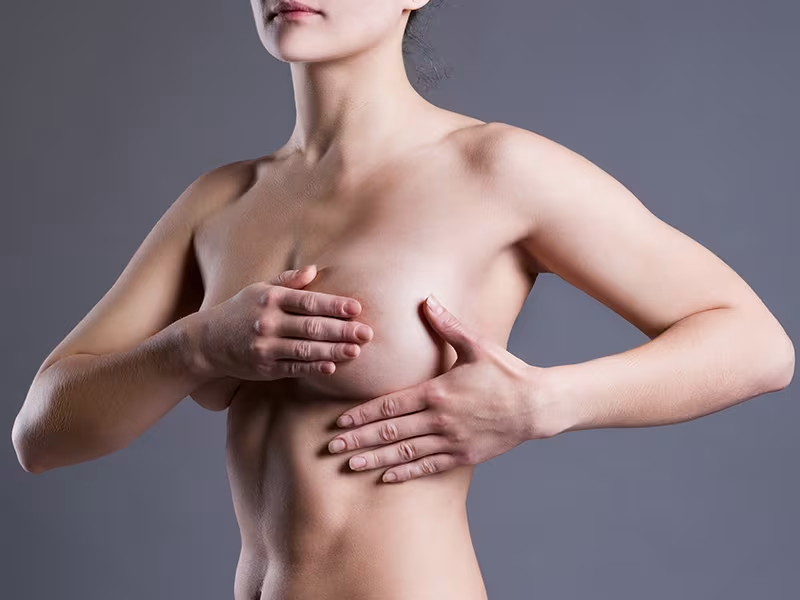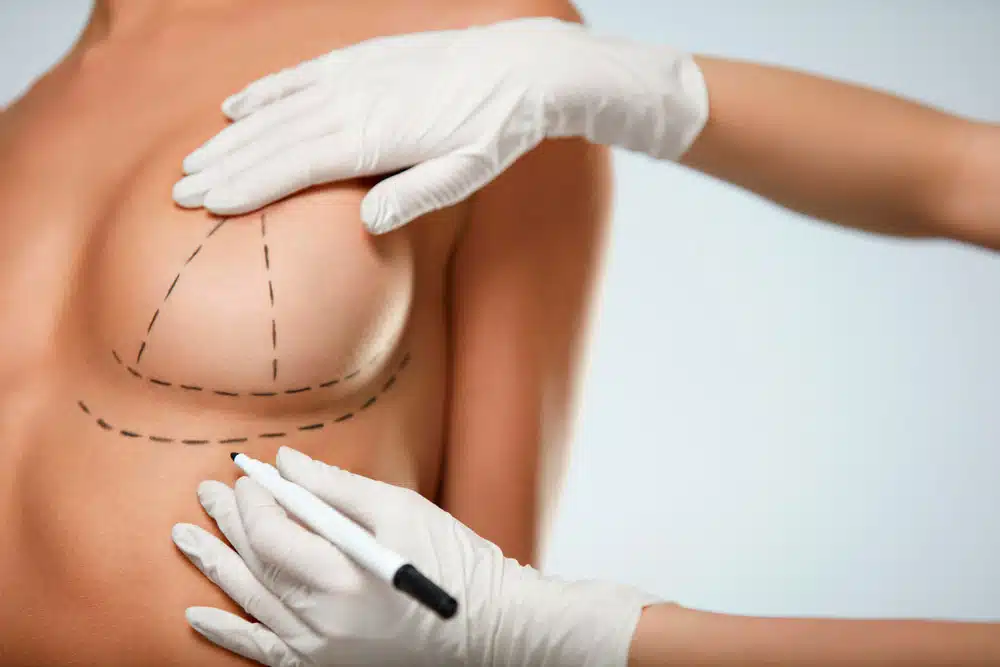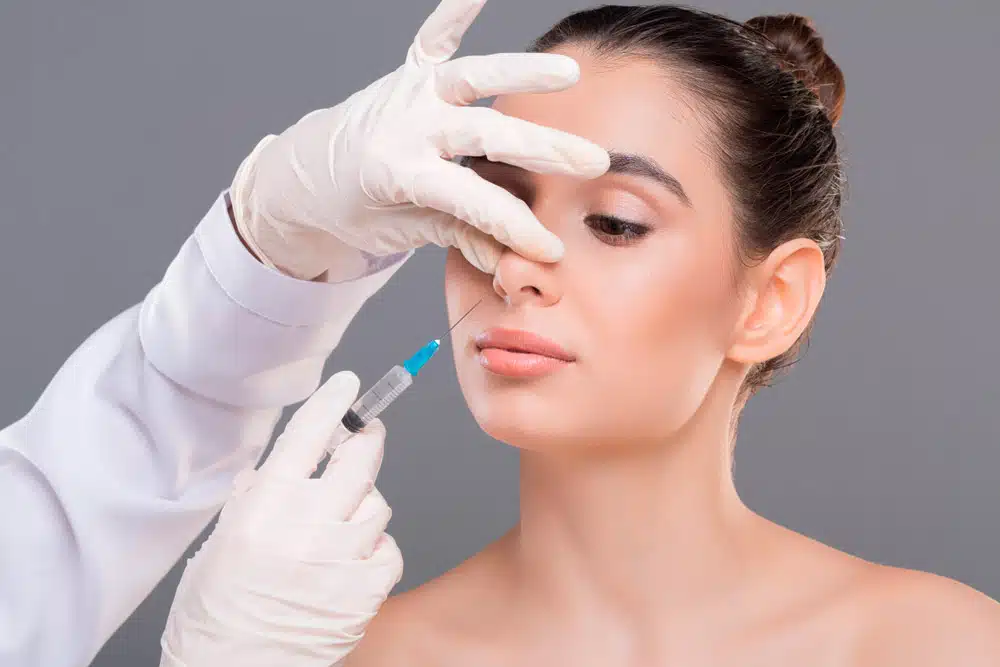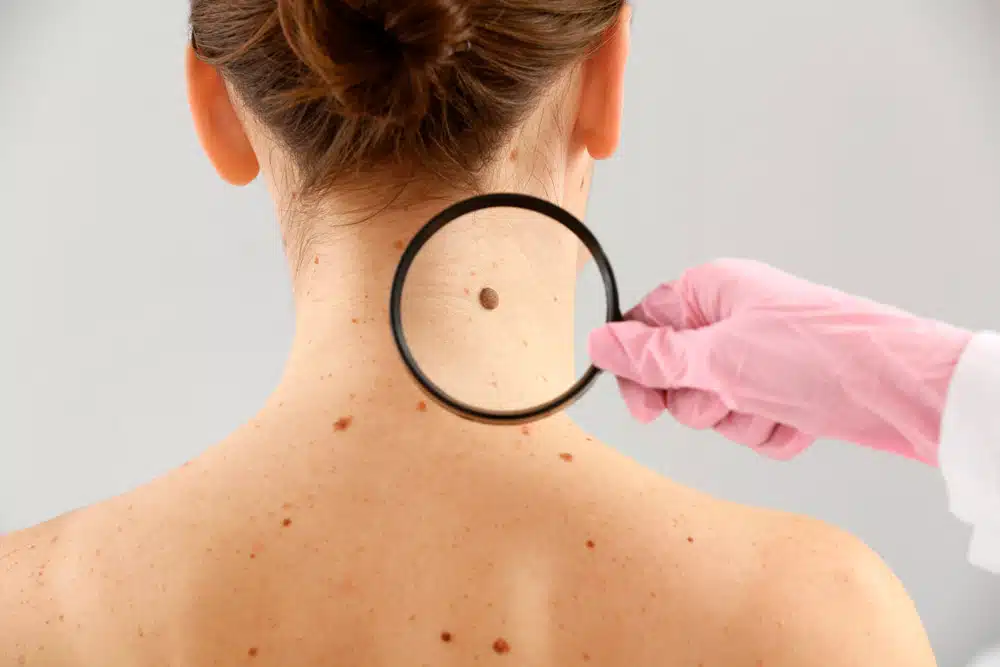Each year more than 200,000 American women face the reality of breast cancer. Today, the emotional and physical results may be very different from what they were in the past. Great strides have been made in our understanding of the disease and its treatment. New approaches in treatment, as well as advances in reconstructive surgery mean that women who have breast cancer or women who have undergone breast reconstruction in the past, have new choices. If you have been told you may need, or if you have already undergone a mastectomy, then breast reconstruction may be an option.

Breast reconstruction is a series of operations with the aim of recreating your breast to its original shape. Surgery rebuilds the breast contour, and if you desire, the nipple or areola (which is the darker area surrounding the nipple). Most women that have a mastectomy can undergo breast reconstruction. Wisconsin plastic surgeon Dr. Ewings has performed many of these restorative surgeries to great success, and you can view some of our before-and-after results below.
- What is Breast Restoration?
- Goals of Breast Reconstruction
- When is the Right Time for a Breast Reconstruction?
- Types of Breast Reconstruction
- Nipple and Areolar Reconstruction
- Breast Reconstruction after Lumpectomy and Radiation Therapy
- Before Breast Reconstruction Surgery
- After the Reconstruction Procedure
- Deciding to Undergo Breast Reconstruction
- Breast Reconstruction Risks
- Breast Reconstruction Frequently Asked Questions
What is Breast Restoration?
The initial step in breast reconstruction is to evaluate the proposed or existing changes secondary to the mastectomy. The types of changes that often occur are the loss of breast skin, breast volume, the nipple, symmetry and contour.
As you are already aware, being faced with the diagnosis of breast cancer forces you to make numerous difficult choices. The prospect of choosing breast reconstruction can cause understandable anxiety because it is an unfamiliar road with many different routes available. Your board certified plastic surgeons are here to guide you along the way by explaining your options. You must make the final decision. However, your plastic surgeon can help to direct you down the path that is best suited for your situation.
This information has been designed to give you the facts you need and help you make a well-informed decision regarding breast reconstruction. You and those close to you are welcome to discuss any questions and concerns about reconstructive surgery with us. If you are considering breast reconstruction, it would be extremely helpful to discuss this with your surgeon and an experienced plastic surgeon prior to your mastectomy. This allows the surgical team to plan the treatment that is best for you, even if you decide to have reconstructive breast surgery done at a later date.
Dr. Ewings’s Experience in Restorative Breast Surgery
For over a decade, Dr. Ember Ewings has taken pride in delivering excellence in plastic surgical care. She earned her medical degree from the University of Wisconsin-Madison School of Medicine, and completed her residency training in plastic surgery at Saint Louis University. Additionally, she gained extensive experience in pediatric and craniofacial surgery during her fellowship at the University of Tennessee – Memphis, and Hôpital Necker-Enfants Malades in Paris, France. She is board Certified by the American Board of Plastic Surgery.
Goals of Breast Reconstruction
Women choose breast reconstruction for many different reasons. The goals of reconstruction are:
- to make your breast look balanced when you are wearing a bra
- to permanently regain your breast contour
- to reconstruct the inframammary fold
- to avoid the use of a cumbersome external prosthesis
The difference between the reconstructive breast and the remaining breast can be seen when you are nude, however, the breast in a bra will be close enough to one another in size and shape so you feel comfortable.
Breast Reconstruction Before and After Photos
* Each patient is unique and individual results may vary.
When is the Right Time for a Breast Reconstruction?
Breast Reconstruction may either be delayed for a period of time after the mastectomy or the reconstruction can be performed at the same time as the mastectomy. In our experience, 90% of our patients select the immediate reconstruction option. Immediate breast reconstruction is performed at the same time as the mastectomy. The advantages of immediate reconstruction are that this approach avoids additional operative time and also avoids an additional anesthetic. It must be noted that in selected situations, immediate reconstruction may not be recommended. Potential situations which may delay reconstruction are the possibility of anticipated wound healing problems or the patientís personal preference. However, it should be noted that in most cases, immediate reconstruction has no impact on the timing of possible post operative chemotherapy or radiation therapy. It is imperative that each patient should work with their plastic surgeon to understand the pros and cons for all available options. With this information, patients can then select the best path for their specific situation.
Types of Breast Reconstruction
Although reconstructive options at first might seem confusing, there are only two techniques available. The first choice would be reconstruction with the use of a breast implant and the second choice would be to reconstruct your new breast with your own tissue (tissue flap). A tissue flap is a section of skin, fat and muscle which is moved from your stomach or other areas of your body to the chest wall area in order to reconstruct the breast.
Breast Reconstruction Utilizing Prosthesis (Implant)
Unfortunately, a mastectomy results in the removal of skin and tissue which often does not leave enough volume to accommodate the breast implant. Therefore, in order to allow for the placement of the breast implant (prosthesis), the skin and tissue must be expanded or stretched. This is done by placement of a tissue expander or an inflatable balloon under the remaining skin and chest wall muscle. The skin is then closed without tension and allowed to heal for several weeks.
Following this, there is a period of serial tissue expansions, or a series of injections through the skin, into the inflatable tissue expander. This is done over a period of several weeks using a small needle through the skin until the expander is completely filled. The expander then can be removed and the permanent implant placed beneath your skin and behind your chest wall muscle, meaning under the pectoralis muscle.
The vast majority of patients report no loss of function or muscle weakness after the implants are placed. This last procedure can usually be done under a mild anesthetic and can often be done on an outpatient basis. Most patients are extremely pleased with the overall improvement of their breast secondary to reconstruction using a permanent prosthesis.
Recently two new types of breast reconstruction have been developed. The first is the Peg procedure. This procedure makes an effort to reduce the size of the patient’s mastectomy scar by making a circular incision around the areola and performing the mastectomy through this opening. Because of this skin sparing technique some patients may be able to avoid the necessary tissue expansion phase. The next procedure, which was developed by Dr. Ember Ewings, focuses on the recreation of the fold beneath the breast, which is often distorted or even lost following most mastectomies. This technique relies on the placement of a suspension suture to help recreate a smooth and natural fold beneath the breast.
What about breast implants?
Breast implants are filled with saline (salt water) or a silicone gel. The implants come in varying sizes and shapes, so that the surgeon can alter the size of the reconstructed breast to mimic the opposite breast.
However, there are several fundamental limitations with the use of implants including:
- The patient may be able to feel the implant, which can give the sensation of folds and rippling.
- Because of the use of the implant there is a slightly higher risk of infection.
- Occasionally the body may attempt to wall off the implant, resulting in a capsular contraction around the implant. This resulting scar formation will be different for each person and its presence may cause a distortion of the shape of the reconstructed breast.
- There is a risk of implant leakage. If the implant is filled with the nontoxic saltwater (saline solution) there is no real problem and the implant can easily be replaced. If there is leakage from a silicone gel implant, the soft tissues surrounding the implant may become damaged secondary to the leakage.
Despite these potential problems, breast implants remain the most common breast reconstructive technique performed in the world because of the overall diminished chance for operative risks.*
If you want to know how much are breast implants in Wisconsin, you have to consider several factors. The most important factor is whether you’re having breast implants done alone or in combination with another cosmetic procedure.
Breast implants Wisconsin price is usually between $5,000-$7,500. However, if you’re combining breast implants with a tummy tuck, liposuction, or some other cosmetic procedure, the total cost may be significantly higher.
Tissue Flap Reconstruction
Tissue flap procedures are those techniques which uses tissue from the tummy area or the back for reconstruction of the breast. These operations leave scars both from where the tissue was taken and on the reconstructive breast. These scars will fade over time, but they never completely go away.
TRAM Flap Procedure
The TRAM flap technique is a type of tissue flap procedure that uses extra tissue and muscle from the lower abdominal wall to reconstruct your breast. There is usually enough tissue in this area alone to create a new breast and therefore, in the vast majority of cases, an implant is not needed. The skin, fat and at least one of the abdominal muscles are moved from the abdomen to the chest area. The obvious secondary benefit of this type of reconstruction is that it results in a tightening of the lower abdomen wall, or tummy tuck but without the need for a separate surgery.
There are two types of TRAM flaps. First, the pedicle flap which involves leaving the flap attached to its original blood supply and tunneling up under the skin to the breast area. Second, the free flap, which means that the surgery cuts the flap of skin, fat, blood vessels and muscle free from its original location and attaches the flap to the blood vessels in the chest area. Latissimus Dorsi flap, another type of tissue flap procedure, moves muscle and skin from your back when extra tissue is needed. The flap is made up of skin, fat, muscle and blood vessels. It is tunneled under the skin to the front of the chest and the tissue is then remodeled to form the new breast. This procedure might also require the use of a small prosthesis.
Nipple and Areolar Reconstruction
The decision to have a nipple and areolar (the dark area around the nipple) reconstructed is strictly up to the patient. Nipple and areolar reconstruction is usually done when the new breast has had some time to heal. Tissue for reconstruction of this new nipple is usually done by small flap procedures located on the reconstructed breast to match the other breast. To recreate the areola, medical tattooing is our technique of choice. In contrast to earlier procedures no skin grafting is required for nipple reconstruction. This is an outpatient procedure and is done under a local anesthetic. 95% of our patients have chosen to have nipple areolar reconstruction.
Nipple and areola anatomy
Nipple-areola anatomy is remarkably variable in dimension, texture, and color across ethnic groups and among individuals. Moreover, an appreciable difference often exists in the two nipple-areola complexes even in the same patient. The nipple is represented by the elevated structure in the center of a pigmented area on the breast mound. Nipple projection results from the primary location of the mammary ducts in the central portion of the nipple complex. This arrangement produces a semi-rigid structure with a significantly more firm and erectile element than the soft and pliable surrounding areola.
Areola reconstruction
- Skin grafts: Because it is a2-dimensional structure, the areola usually does not pose the same degreeof difficulty in reconstruction as the nipple. Time-honored methods of reconstruction included skin grafts obtained from the opposite nipple-areola complex or the medial thigh-vulva area. These grafts are intended to provide pigmented tissue that closely resembles the nativeareola. Currently, with great improvements in tattoo technique and a seemingly endless variety of pigments available, it seems unjustifiable toexpose a patient to the risks of possible donor site complications to obtain the same or less satisfactory results than those obtainable with tattooing.
- Banking: The practice ofbanking portions of the excised areola to use as grafts in thereconstruction process is mentioned only to condemn it. The have been reported cases where the banked nipple contains cancer cells and wouldtherefore run the risk of transferring these cells to the reconstructed nipple. These areola grafts used for areola reconstruction are unpredictable in terms of degree and direction of contraction and possible loss of pigmentation after transplantation. Typically, skin grafts are justified if they are needed to close the nipple donor site on there constructed nipple-areola complex, but, otherwise, little indication exists for their use.
- Tattoo: Tattooing of there constructed breast in the area of the expected nipple areola complex issimple, easy to perform, readily correctable, and requires no significant patient participation or convalescence. Reconstruction of the areola bytattooing can be staged and often requires some touch-up, but it allows agreat degree of control over size, definition of contour, and color matchwith the opposite side. However, results are usually less than satisfactory when used in the absence of nipple reconstruction.
- Tattooing is strictly anoptical effect, with no structural support and no way to reproduce the projection and texture typical of the natural nipple-areola complex.Thus, tattooing is best employed as one stage of a combined approachtoward nipple reconstruction, whether performed prior to or afterelevation of the nipple structure.
- Many tattoo pigments are available, allowingprecise color matching with the opposite areola. A color shade a little darker than the desired color is selected to allow for some fading, whichinvariably occurs in the weeks after the procedure.
Nipple reconstruction
Most methods of nipple reconstruction can be used whether or not the breast has been reconstructed with a flap or a prosthesis. Flaps generally provide more mobile tissue and make it easier to achieve nipple bulk and projection. Previous scars from the mastectomy or previous biopsies need to be accounted for in terms of flap design so as not to compromise blood supply to the reconstructed nipple.
Timing of nipple replacement
Nipple replacement isn’t scheduled until at least two months after breast reconstruction surgery. By that time, the swelling will go down and your breast will settle into its “natural” sag. The nipple can then be positioned properly during nipple replacement
- The most challenging aspect ofnipple reconstruction is the creation of a 3-dimensional projectingstructure with texture, dimensions, and contour similar to the opposite nipple.Moreover, the reconstruction must be lasting. Nipple reconstructionenhances the realism of breast reconstruction; the more projecting and3-dimensional the structure, the more lifelike the reconstruction. Variousoptions have included banking, nipple sharing, grafting, and local flaps.
- Nipple sharing can potentiallyharm the only erogenous structure left in the woman’s breast, as thesurgeon must decrease the projection and alter the structure of the oppositenipple to match the reconstructed one. Considering all the possiblealternative options, this seems the least likely to be recommended.
- Nipple reconstruction withlocal flaps is achieved with various techniques, each with its ownproponents and benefits. These include the skate flap, bell flap, doubleopposing tab flap, star flap, top-hat flap, twin flap, propeller flap, Sflap, rolled dermal-fat flap, and the patient’s own cartilage.Recently, use of the synthetic materials and filler injection to restorenipple projection has also been reported. Some of the most commonly usedtechniques are described below.
Recovery after nipple areolar reconstruction
This procedure offers an extremely limited recovery period for two reasons.
- There is little to postoperative pain because of the diminished sensation of the reconstructed breast mound.
- This is a short procedure done under a local anesthetic and on an outpatient basis.
It is our experience that the vast majority of patients return to a near normal level of activity within 1 to two days after the above procedures.
Breast Reconstruction after Lumpectomy and Radiation Therapy
There is a common misconception that following radiation therapy breast reconstruction can not be performed. This is totally inaccurate. Following lumpectomy there may occur varying degrees of disfigurement of the breast. In a large breasted woman, the lumpectomy may produce no appreciable difference from the opposite breast. In a smaller breasted woman, the same procedure may produce such asymmetry and disfigurement that breast reconstruction may be an option. Radiation does however damage the tissue and it is often the case that a flap procedure may be the appropriate technique for breast reconstruction.
Why Choose Dr. Ember Ewings
For over a decade, Dr. Ember Ewings has taken pride in delivering excellence in plastic surgical care. She earned her medical degree from the University of Wisconsin-Madison School of Medicine and completed her surgical residency training in plastic surgery at Saint Louis University. Additionally, she gained extensive experience in pediatric and craniofacial surgery during her fellowship at the University of Tennessee – Memphis, and Hôpital Necker-Enfants Malades in Paris, France. Dr. Ewings is also Board Certified by the American Board of Plastic Surgery.
Dr. Ewings has enjoyed caring for patients of all ages from across the upper Midwest, and performs both cosmetic surgical, non-surgical, and reconstructive procedures, and is delighted to be able to provide outreach services in Durand, Wisconsin.
She owns and operates the Plastic Surgery Clinic of Eau Claire in Eau Claire. Prospective patients can reach Dr. Ewings through her online Consult Form, or at her practice, Plastic Surgery Clinic of Eau Claire – 715.833.2116 or 800.456.8222.
Before Breast Reconstruction Surgery
Planning Breast Reconstruction surgery
Discussion about reconstruction can begin as soon as you know you have breast cancer. Your breast surgeon and plastic surgeon need to work together to come up with the best possible plan for your reconstruction. Because of Dr. Ewings’s years of experience working with skilled general surgeons, their coordinated efforts to find the right approach for each breast reconstruction patient have been extremely beneficial. Dr. Ewings has performed more than 800 breast reconstruction procedures.
After checking your health, you surgeon will explain which reconstructive options are best for your age, health, body type, life style, tissues and goals. Your plastic surgeon should be frank with you when talking to you about the risks and benefits for each operation. If you would like to talk with someone who has had your type of surgery, our office will be more than happy to discuss these procedures with you and to put you in touch with other patients who have undergone various types of breast reconstruction. Your surgeon should also be able to explain the details of your surgery including
- the type of anesthesia that will be used
- where the surgery will take place
- what to expect after surgery
- the fact that insurance carriers must cover reconstructive procedures.
- Health insurance questions regarding breast reconstruction can easily be answered by contacting our office.
Preparing for Breast Reconstruction surgery
Your breast surgeon and your plastic surgeon will give you specific instructions on how to prepare for surgery; guidelines of eating and drinking, smoking, and taking or avoiding certain medications for a period of time before your surgery. You may also require some skin marking at least 24 hours before surgery.
After the Reconstruction Procedure
You will likely feel sore and tired for a week or two after implant reconstruction and longer after flap procedures. You will be prescribed medications for pain or discomfort. Our reconstructive patients have rated the pain for implant reconstructions to be between 3 and 4, and for flap procedures, the pain is rated between 4 and 6 on a scale of 1 to 10. This postoperative pain will fade over a period of 1 to 7 days. You may be discharged with surgical drains in place in order to help remove any excess fluid that may accumulate at the operative site. Most patients are discharged home within 24 hours following the implant reconstruction and in 2 to 3 days after the flap procedure. You will receive a drain and wound care instruction sheet prior to your discharge home after your reconstruction. On the 2nd to 3rd post-operative day, you will be up around the house. On days 4 through 10, you may be venturing out, as you feel comfortable, and you should be able to drive within 10 to 14 days. You should be able to perform light work, i.e. secretarial, in 2-3 weeks, and strenuous activity may begin in 6-8 weeks. If you decide on the tissue flap procedure, your recovery will be approximately 30% longer than with the implant reconstruction. Most patients will be seen in follow-up in 1 week, 1 month, 3 months, and 1 year following reconstruction.*
Some things to remember after Breast Reconstruction surgery:
- Reconstruction does not restore normal sensation to your breast, but some feeling may return,
- It may take one to two years for tissues to completely heal and scars to fade,*
- Follow your surgeon’s advice on when to begin exercising and normal activity.
- Women who have had reconstructive surgery may go through a period of emotional adjustment once they have a reconstructed breast. It takes time to become adjusted to your new breast and you may feel anxious and confused as you begin to think of the reconstructed breast as your own.
- Most patients relate that it takes at least a year for them to accept the newly reconstructed breast as their own.*
- We have found that talking with other women who have had reconstruction has been extremely helpful for our patients and that is a service that we gladly provide through the Restorative Breast Center.
Is there a need for a second opinion prior to your breast reconstruction?
Because of the many facets of breast reconstruction we encourage any patient contemplating breast restorative surgery to seek a second opinion. Approximately 50% of our patients have come to us for a second opinion regarding their reconstructive options.
Have you undergone a previous breast reconstruction and would you like an evaluation of your result?
Approximately 20% of our patients that inquire about restorative surgery have undergone a previous breast reconstruction and have questions regarding the outcome of their reconstruction; if there is any need for a breast revision to improve the appearance of their reconstructed breast; and to see if there are any new techniques that may be available.
Insurance issues relative to restorative breast surgery
As noted earlier, it is mandated that all insurance carriers must provide coverage for all procedures and office visits for breast reconstruction. And most carriers also cover any procedures performed on the opposite breast when they are deemed necessary.
Breast reconstruction and cancer recurrence
It has been well documented that breast reconstruction has no effect on the recurrence of breast cancer and we are not aware of any evidence whatsoever that correlates recurrence rate with the use of any prosthesis for breast reconstruction.
Deciding to Undergo Breast Reconstruction
I and my staff hope that this information will be of help to you during this difficult time. Our staff has gained a considerable amount of knowledge regarding breast reconstruction because of their experience in helping nearly 500 patients manage this difficult problem. Over a twenty-year period our staff has been trained to respond to you and your families concerns when facing the diagnosis, treatment and effects of breast cancer. Please feel free to contact my office with any concerns or questions that you might have. If my staff cannot answer your preliminary questions, please feel free to contact me and I will personally respond to your question.
Breast Reconstruction Risks
There is a potential for complications in any operative procedure. The most common being infection, scarring and sensation changes. During your consultation, a detailed discussion of these potential risks will be given to you.
Breast Reconstruction Frequently Asked Questions

Breast Lift
Dr. Ewings customizes each breast lift to match her patient’s unique aesthetic goals for beautifully-shaped, perky breasts and lifted nipples.

Liquid Rhinoplasty
Dr. Ewings can fill in indentations, subtly improve the shape of the nose, and even enhance facial balance by making small adjustments to the nose.

Skin Cancer Treatment
Skin cancer is the most common form of cancer in the United States. More than 600,000 new cases are reported each year.











